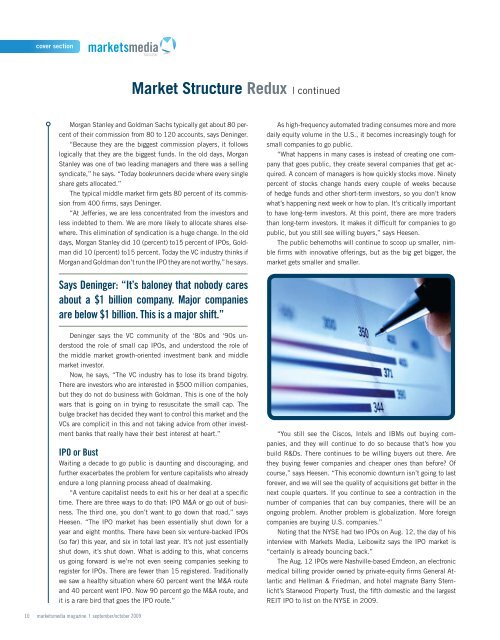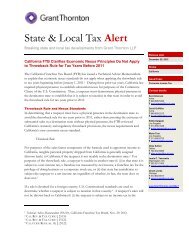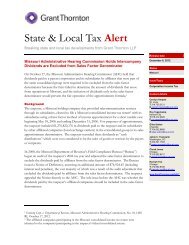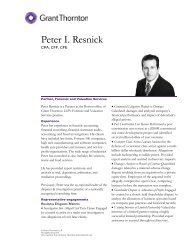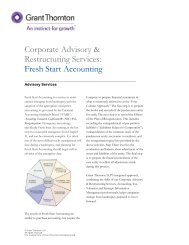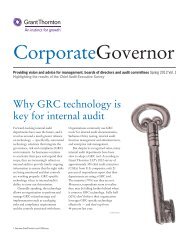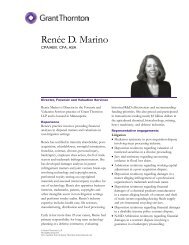Market Structure Redux - Grant Thornton LLP
Market Structure Redux - Grant Thornton LLP
Market Structure Redux - Grant Thornton LLP
Create successful ePaper yourself
Turn your PDF publications into a flip-book with our unique Google optimized e-Paper software.
cover section<br />
<strong>Market</strong> <strong>Structure</strong> <strong>Redux</strong> I continued<br />
Morgan Stanley and Goldman Sachs typically get about 80 percent<br />
of their commission from 80 to 120 accounts, says Deninger.<br />
“Because they are the biggest commission players, it follows<br />
logically that they are the biggest funds. In the old days, Morgan<br />
Stanley was one of two leading managers and there was a selling<br />
syndicate,” he says. “Today bookrunners decide where every single<br />
share gets allocated.”<br />
The typical middle market firm gets 80 percent of its commission<br />
from 400 firms, says Deninger.<br />
“At Jefferies, we are less concentrated from the investors and<br />
less indebted to them. We are more likely to allocate shares elsewhere.<br />
This elimination of syndication is a huge change. In the old<br />
days, Morgan Stanley did 10 (percent) to15 percent of IPOs, Goldman<br />
did 10 (percent) to15 percent. Today the VC industry thinks if<br />
Morgan and Goldman don’t run the IPO they are not worthy,” he says.<br />
As high-frequency automated trading consumes more and more<br />
daily equity volume in the U.S., it becomes increasingly tough for<br />
small companies to go public.<br />
“What happens in many cases is instead of creating one company<br />
that goes public, they create several companies that get acquired.<br />
A concern of managers is how quickly stocks move. Ninety<br />
percent of stocks change hands every couple of weeks because<br />
of hedge funds and other short-term investors, so you don’t know<br />
what’s happening next week or how to plan. It’s critically important<br />
to have long-term investors. At this point, there are more traders<br />
than long-term investors. It makes it difficult for companies to go<br />
public, but you still see willing buyers,” says Heesen.<br />
The public behemoths will continue to scoop up smaller, nimble<br />
firms with innovative offerings, but as the big get bigger, the<br />
market gets smaller and smaller.<br />
Says Deninger: “It’s baloney that nobody cares<br />
about a $1 billion company. Major companies<br />
are below $1 billion. This is a major shift.”<br />
Deninger says the VC community of the ‘80s and ‘90s understood<br />
the role of small cap IPOs, and understood the role of<br />
the middle market growth-oriented investment bank and middle<br />
market investor.<br />
Now, he says, “The VC industry has to lose its brand bigotry.<br />
There are investors who are interested in $500 million companies,<br />
but they do not do business with Goldman. This is one of the holy<br />
wars that is going on in trying to resuscitate the small cap. The<br />
bulge bracket has decided they want to control this market and the<br />
VCs are complicit in this and not taking advice from other investment<br />
banks that really have their best interest at heart.”<br />
IPO or Bust<br />
Waiting a decade to go public is daunting and discouraging, and<br />
further exacerbates the problem for venture capitalists who already<br />
endure a long planning process ahead of dealmaking.<br />
“A venture capitalist needs to exit his or her deal at a specific<br />
time. There are three ways to do that: IPO M&A or go out of business.<br />
The third one, you don’t want to go down that road,” says<br />
Heesen. “The IPO market has been essentially shut down for a<br />
year and eight months. There have been six venture-backed IPOs<br />
(so far) this year, and six in total last year. It’s not just essentially<br />
shut down, it’s shut down. What is adding to this, what concerns<br />
us going forward is we’re not even seeing companies seeking to<br />
register for IPOs. There are fewer than 15 registered. Traditionally<br />
we saw a healthy situation where 60 percent went the M&A route<br />
and 40 percent went IPO. Now 90 percent go the M&A route, and<br />
it is a rare bird that goes the IPO route.”<br />
“You still see the Ciscos, Intels and IBMs out buying companies,<br />
and they will continue to do so because that’s how you<br />
build R&Ds. There continues to be willing buyers out there. Are<br />
they buying fewer companies and cheaper ones than before? Of<br />
course,” says Heesen. “This economic downturn isn’t going to last<br />
forever, and we will see the quality of acquisitions get better in the<br />
next couple quarters. If you continue to see a contraction in the<br />
number of companies that can buy companies, there will be an<br />
ongoing problem. Another problem is globalization. More foreign<br />
companies are buying U.S. companies.”<br />
Noting that the NYSE had two IPOs on Aug. 12, the day of his<br />
interview with <strong>Market</strong>s Media, Leibowitz says the IPO market is<br />
“certainly is already bouncing back.”<br />
The Aug. 12 IPOs were Nashville-based Emdeon, an electronic<br />
medical billing provider owned by private-equity firms General Atlantic<br />
and Hellman & Friedman, and hotel magnate Barry Sternlicht’s<br />
Starwood Property Trust, the fifth domestic and the largest<br />
REIT IPO to list on the NYSE in 2009.<br />
10<br />
marketsmedia magazine I september/october 2009


